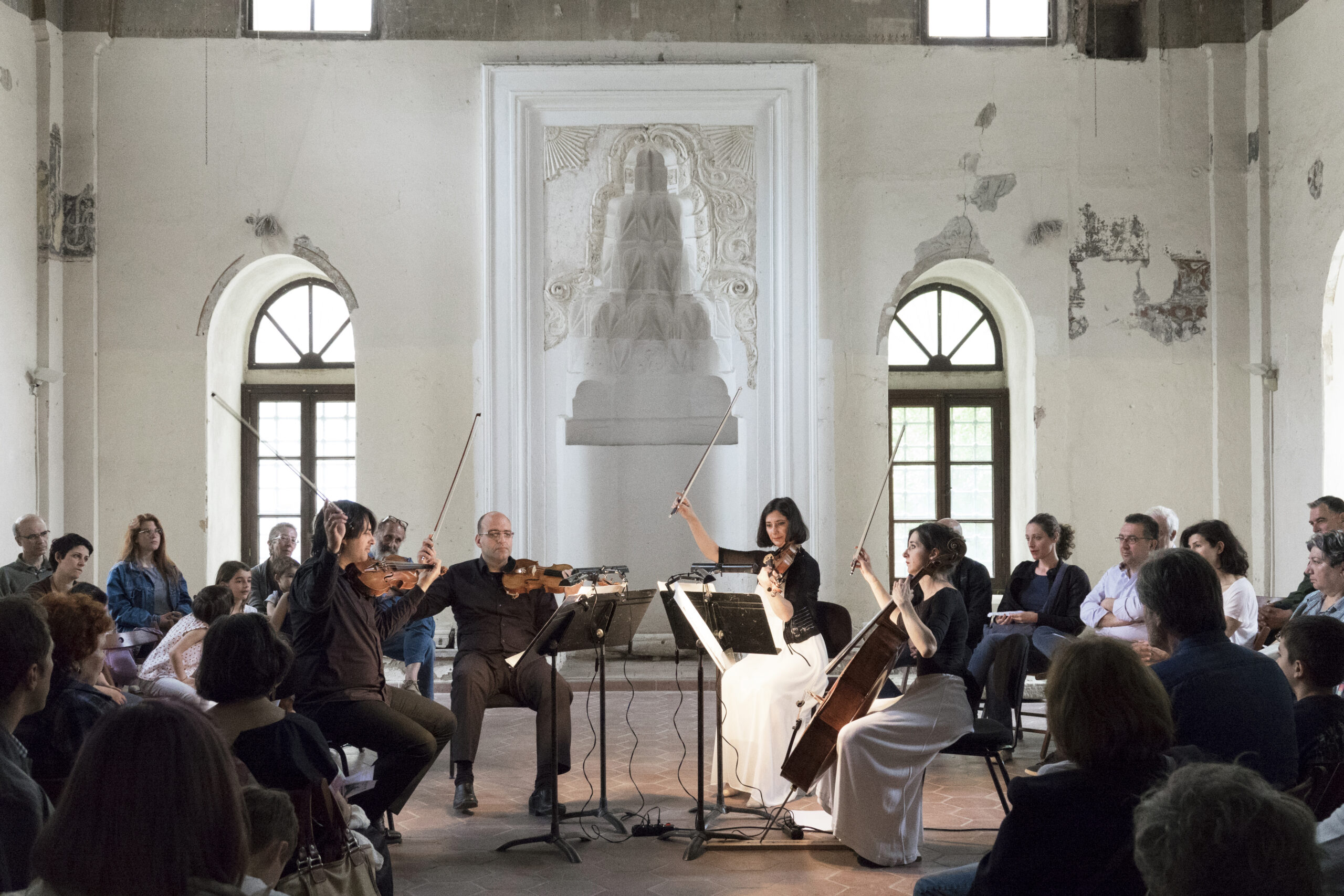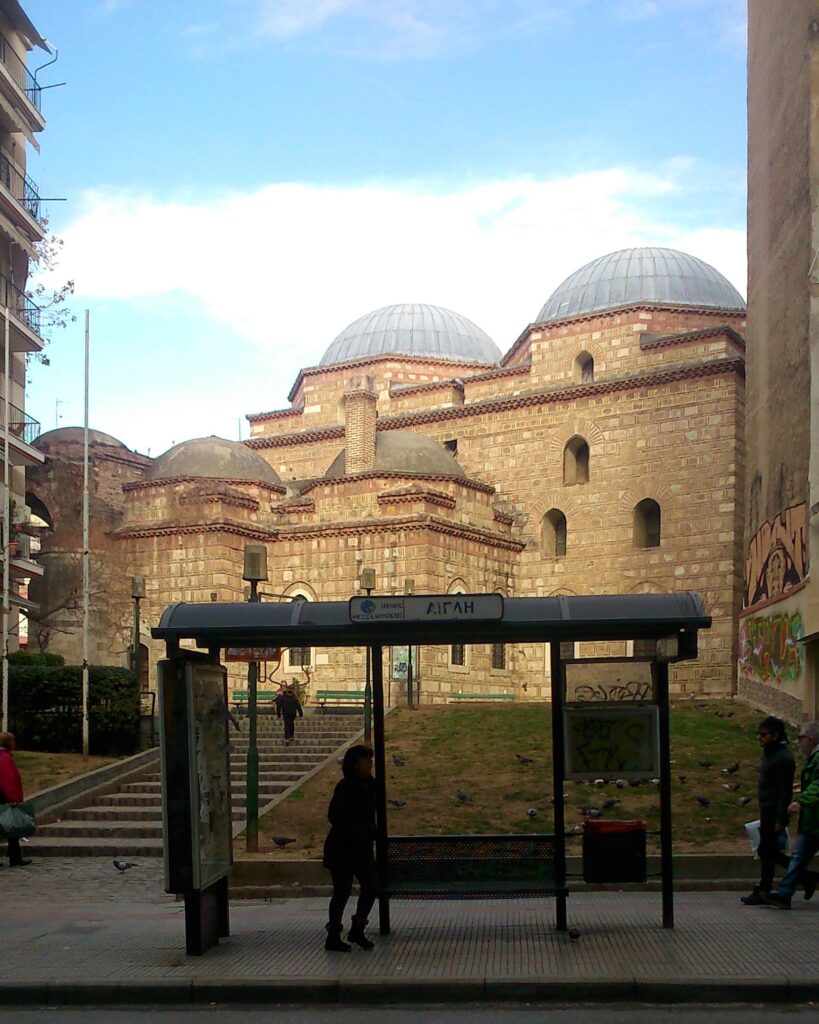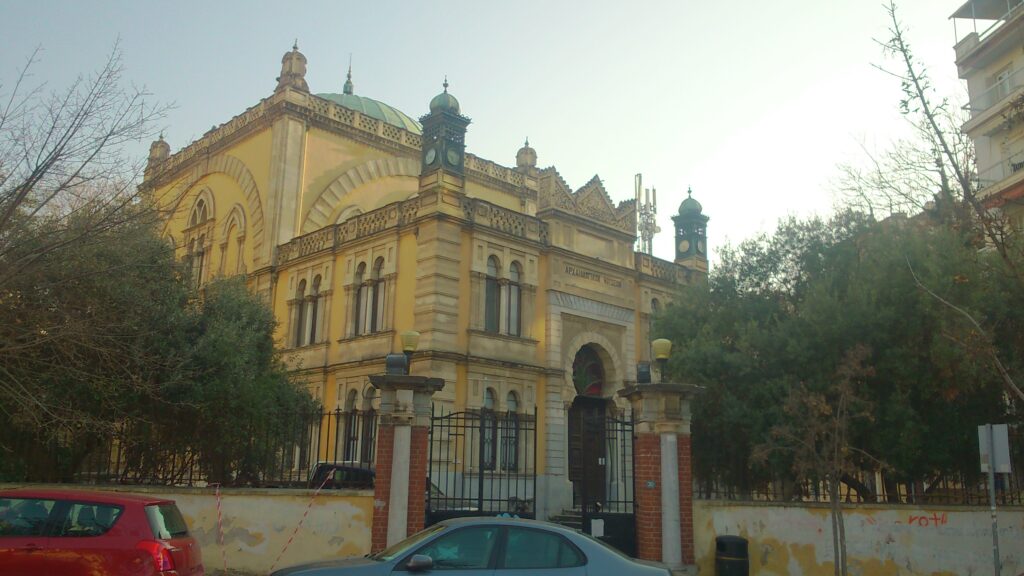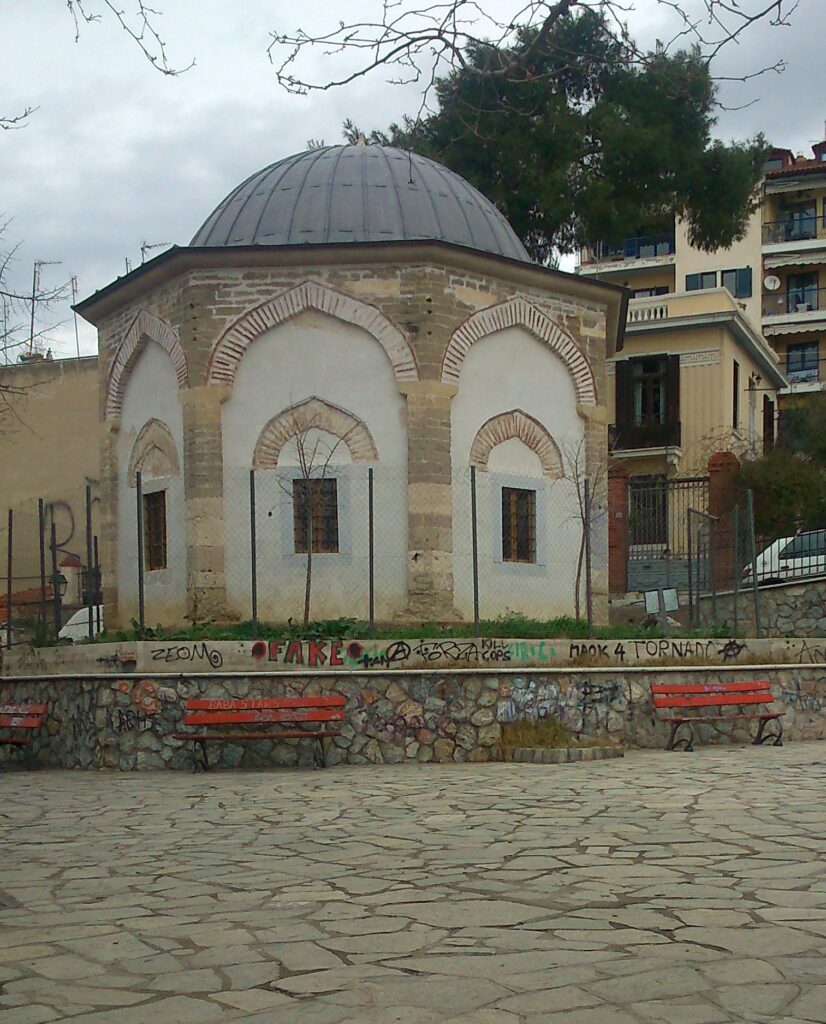
© Nikos Zisiadis, Dark Room Studio. Alatza Imaret mosque – Thessaloniki
Thessaloniki, Greece, is best known for its rich Byzantine heritage. Like most Greek cities, its identity is usually presented as exclusively Greek and Orthodox. What is less known about it, is its rich heritage of two other religions: Judaism and Islam. One may find it hard to imagine that at the start of the century, the skyline of the city was dominated by minarets. In this article, we’ll have a small introduction to the Muslim religious monuments of Thessaloniki.
In 1430, the prominent Byzantine city fell to the hands of the Ottoman Empire. The ottomans put their mark on the city, starting with the transformation of the most important churches into mosques. In addition to these transformed sanctuaries, mosques would be constructed in the next decades. The city spent 482 years as a major city of the Ottoman Empire – Selanik being its Turkish name – and many more mosques were to be built throughout these centuries. Finally, in 1912, during the Balkan Wars, the city was captured by the Greek army. It was the turning of a very different page in its history.
This was soon to be followed by two other dramatic events. In 1917, a massive fire destroyed a great part of its historical core together with many monuments. Then, in 1923, Greece and Tukey signed the treaty of Lausanne, which dictated the compulsory exchange of Muslim and Christian populations between the two countries. This meant that all the Muslims in Thessaloniki had to leave for Turkey. Violently and suddenly, the centuries-long Muslim community disappeared from the city. At the same time, thousands of Christian refugees arrived; they would form a basic pillar of the future evolution of the city and its cultural identity.

The only open view to Alatza Imaret, from the nearby Kassandrou street. © Manthos Velogiannis
Some words should be said on the position of the Ottoman past in Greek historiography. The modern Greek national myth revolves around a linear narrative, stretching from antiquity to today. The shared and multicultural aspect of this long history is largely downgraded, as well as the conflictual points in it. In this brave story, there is only one large, dark parenthesis: the Ottoman rule. Greeks are not being taught the history of this period. They only learn to consider it as a void, an era where nothing happened except for oppression and despair. This can explain the usual lack of knowledge regarding the many traces of the Ottoman past that are scattered throughout Greece, as well as some acts of active destruction of Ottoman monuments. Not only these monuments were considered symbols of an era of national oppression, completely exterior and inferior to the Christian identity of the Greeks, but also the opposite of progress and modernisation.
Of all the 28 mosques (cami’i and mescid) that existed in Thessaloniki at the time of the Greek conquest, 7 exist today (to our knowledge). The most central of them is Hamza Bey Mosque, standing at a key crossroads since 1468. The mosque had two main building phases: at first, it was built as a rectangular mescid and then an atrium surrounded by colonnades was added. After the population exchange, it was sold to private actors and became a shopping centre. Separating walls were built inside the building, dividing it into numerous small shops. The central space of the atrium was turned into a cinema, with the addition of a metal roof. The cinema took the exotic name Alkazar, perhaps a poor reflection of the oriental appearance of the building. While in the 1950s the cinema was a successful enterprise, it fell into decline in the 1970s, ending up showing porn. Despite being a monument since 1926, it was only in 2006 when the building came into the hands of the Ministry of Culture and its commercial use stopped. This led to large rescue interventions, in which all the added elements were demolished. Some years later, a new challenge hit the monument, with the construction of the subway, which passes just below its southeast corner.
Another mosque that still can be found in the city is Alatza Imaret. “Alatza” means “colourful”, referring to the colourful tiles that decorated the – today absent- minaret. It was the mosque of one of the many imarets, (Muslim shelters for the poor). The visitor must know where to look to find Alatza Imaret. It is located on a tiny square, enclosed in the centre of a typical Greek urban block with 6-floor apartment buildings. It bears an impressive lotzia, and a double-domed central space. The abandonment throughout the years caused significant damage. Today, it is used as a venue for cultural events.

Yeni Mosque. © Manthos Velogiannis
The best-conserved mosque of Thessaloniki, Yeni Mosque, is, perhaps unsurprisingly, the last one to be built before the Greek conquest. Its style brings it in sharp contrast with the rest of the mosques in the city: built in 1902 by the Italian architect Vitaliano Posell (who designed several buildings in the city), it is a child of the eclectic era. It bears Moorish elements, popular in the age, together with neoclassical features. The most interesting thing around this mosque though can be made visible if someone happens to notice, above its entrance, a David’s star. The mosque was built for the Donme, a religious group of Jewish who converted to Islam. This community happened to have some rather rich and influential members at the turn of the centuries, who funded the construction of the mosque not in the old-fashioned and packed old city, but in the developing suburban era of Exohes. This beautiful and unique mosque was turned into the archaeological museum of the city from 1925 to 1968. Later it became a cultural venue. Since 2012, the mayor Giannis Boutaris allowed Muslim ceremonies in it in the two most important religious fiests, marking a new approach towards the city’s Muslim past.
In none of the abovementioned mosques can someone find a minaret. It is not a coincidence. The minarets of Thessaloniki were purposefully destroyed right after the expulsion of the Muslims, by order of the municipal council. The reason behind the decision was to allow for ”the remembrance of the Turkish rule to be extinguished”. To the general appraisal of the act, a rare exemption was the voice of the social democrat politician A. Papanastasiou, who saw the aesthetic value of the minarets, considering them part of “national wealth”. Sadly, it was too early for such views.

Musa Baba türbe. © Manthos Velogiannis
Only one Minaret was exempted from the destruction. The mosque to which it was attached was before a church. The church was built in the early 4th century as a Roman temple or mausoleum, a part of the imperial complex that tetrarch Galerius built in his capital. Thus, in this sole monument, one can read the whole history of Thessaloniki.
Some other monuments need the visitor to really know where to look. In the corner of a military camp, near the city centre, one can find a peculiar church of octagonal shape, with a wide dome. It used to be the mosque of the same military camp when it served the Ottoman army. In yet another (former) military camp in the outskirts neighbourhood of Stavroupoli, a mosque was identified just a few decades ago. The dome-less building was used as storage throughout the 20th century. It was threatened by demolition due to the expansion of the nearby road but, fortunately, was saved. With a special operation, it was moved some metres away.
There are two more mosques in Thessaloniki, one of them was identified as such only recently. We cannot finish this small introduction without mentioning the 16th-century Türbe of Musa Baba, a tiny octagonal mausoleum which one can find if they are willing to walk uphill to the old town and reach Terpsitheas Square. The once important resting place of a Muslim saint was used throughout the years as a market kiosk and the office of a local football club. Nowadays, it has been restored.
In the last few decades, Thessaloniki has started caring for its ottoman monuments. Unfortunately, some of the damage done by the almost absolute lack of protection and the various uses through the 20th century is irreversible. Yet, the turning of the page is visible and new opportunities are opened for these monuments. In most cases, they house cultural events. In a way, we could say that arts and culture bear common elements to religion, such as initiation and awe. If we think about it that way, we could say that culture is a very suitable contemporary use for religious spaces that history left empty of their believers. At the same time, such spaces can function as enablers of a diverse and thoughtful collective memory.
Manthos Velogiannis, MA Heritage and Memory Studies, MEng Architecture.





Follow us: